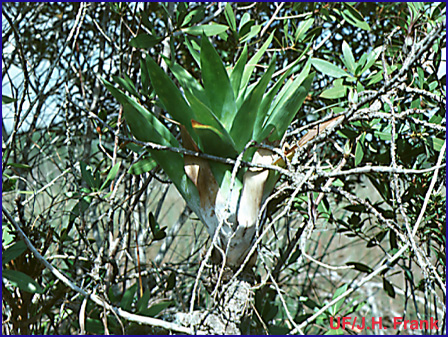
version of October 1996

Catopsis berteroniana in nature: (Photo: J.H. Frank)
Please cite this document as: Frank, J.H. 1996. Carnivorous bromeliads. Published on WWW at http://BromeliadBiota.ifas.ufl.edu/carnbr.htm
Decomposing materials of plant origin (leaves, seeds and twigs) are a familiar sight in the water impounded by tank bromeliads. Decomposition by bacteria and fungi breaks down these materials to simpler ones which can be absorbed by trichomes lining the bromeliad tanks. Among these plant materials are sometimes found dead and drowning non-aquatic insects which have been trapped accidentally but likewise provide nutrients for the bromeliads. That decomposed insects should provide food to tank bromeliads is no more surprising than that decomposed insects form part of the humus of the soil from which other plants absorb nutrients through their roots.
Catopsis berteroniana At least two bromeliads seem to have evolved a greater ability to trap insects and to gain a substantial proportion of their diet from this source. The first to be noticed was Catopsis berteroniana. This species typically grows as an epiphyte, and its range is from southern Florida to southern Brazil. Sometimes it grows in partial shade of tree canopies, but sometimes its position is on a branch or twig where it is not shaded. The same bromeliad has been seen growing on telephone lines where, again, it is unshaded. Those plants that are partially shaded may trap falling leaves, twigs and seeds, but those that are completely exposed might seem to have to rely on wind-blown materials from which to extract their nutrients. A glance inside the bromeliad tank often shows the presence of dead non-aquatic insects (3,6). It has been shown experimentally that C. berteroniana traps many times more non-aquatic insects than do other bromeliads of comparable size (4). A waxy powder which coats the leaf bases, and to a lesser extent the leaf blades, of the plant, may provide the means of entrapment (3,6). The powder reflects ultraviolet light and may confuse insects that fly during daylight into perceiving the powder (and thus the plants) as open sky - so that they crash into it instead of avoiding it. The powder is slippery, like talcum powder, and it appears to hinder fallen insects from escaping from the tank of the bromeliad. There is room for experimental confirmation of the assumed method of attraction.
Brocchinia reducta. The second plant to be noticed was Brocchinia reducta. It is terrestrial rather than epiphytic, grows in nutrient-poor soils in southern Venezuela and Guyana, is seldom shaded by other vegetation, and its tanks often contain dead insects, such as ants (5). A sweet odor emanating from the tank may be the means of attracting insects (5). Its leaves, too, produce a waxy powder which, as in Catopsis berteroniana, seems to prevent escape of trapped insects (5). The highly acid water in its tank (5) may help the action of proteases in digesting insect bodies (2). Neither this plant nor C. berteroniana has been shown to produce proteases (unlike more familiar carnivorous plants such as Nepenthes and Sarracenia pitcher plants), but it could be argued that production of proteases by these plants would be an unnecessary expenditure of energy when bacterial and fungal decomposition of materials already functions in the tanks, and a means of absorption (trichomes) is present.
Mosquito larvae inhabit the tanks of C. berteroniana (1,3,4) and of B. reducta (5,7) just as they do the pitchers of Nepenthes spp. and Sarracenia purpurea.
REFERENCES
1. Barrera R., R., Medialdea, V. 1996. Development time and resistance to starvation of mosquito larvae. Journal of Natural History 30: 447-458.
2. Benzing, D.H. 1986. Foliar specialization for animal-assisted nutrition in Bromeliaceae. p. 235-256 in Juniper, B., Southwood, R. (eds.). Insects and the plant surface. London; Edward Arnold, viii + 360 p.
3. Fish, D. 1976. Structure and composition of the aquatic invertebrate community inhabiting epiphytic bromeliads in south Florida and the discovery of an insectivorous bromeliad. Ph.D. Dissertation, University of Florida, Gainesville, ix + 78 p.
4. Frank, J.H., O'Meara, G.F. 1984. The bromeliad Catopsis berteroniana traps terrestrial arthropods but harbors Wyeomyia larvae (Diptera: Culicidae). Florida Entomologist 67: 418-424.
5. Givnish, T.J., Burkhardt, E.L., Happel, R.E., Weintraub, J.D. 1984. Carnivory in the bromeliad Brocchinia reducta, with a cost/benefit model for the general restriction of carnivorous plants to sunny, moist, nutrient-poor habitats. American Naturalist 124: 479-497.
6. Ward, D.B., Fish, D. 1979. Powdery Catopsis p. 74-75 in Ward, D.B. (ed.) Rare and endangered biota of Florida. Vol. 5, Plants. University Presses of Florida; Gainesville, xxix + 175 p.
7. Zavortink, T.J. 1986. The occurrence of Runchomyia frontosa in carnivorous bromeliads in Venezuela with notes on the biology of its immatures (Diptera, Culicidae, Sabethini). Wasmann Journal of Biology 44: 127-129.
8. González, J.M., Jaffe, K., Michelangeli, F. 1991. Competition for prey between the carnivorous Bromeliaceae Brocchinia reducta and Sarraceneacea [sic] Heliamphora nutans. Biotropica 23: 602-604.